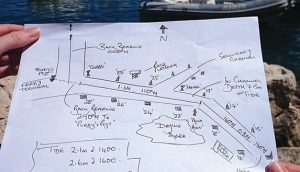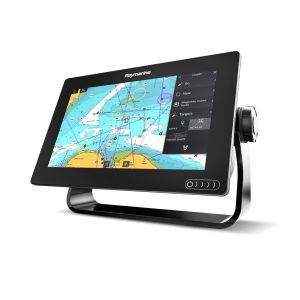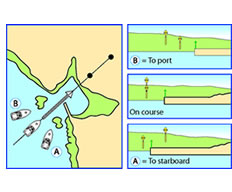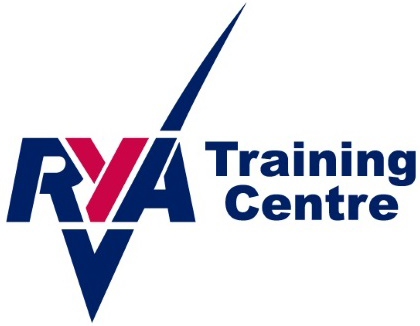Being one step ahead of the game is key to effective pilotage.
 Pilotage is the part of navigation required to enter and depart a harbour. The key to effective pilotage is being one step ahead of the game. Only then will you know what to expect and what’s lurking around the next bend. Constructing a solid pilotage plan before you leave plays an essential part so that all the necessary information is to hand.
Pilotage is the part of navigation required to enter and depart a harbour. The key to effective pilotage is being one step ahead of the game. Only then will you know what to expect and what’s lurking around the next bend. Constructing a solid pilotage plan before you leave plays an essential part so that all the necessary information is to hand.
Confidence in a variety of pilotage techniques gives us a greater chance of success in pilotage because if one technique does not work, another should. Above all, the techniques should be simple and easy to understand.
Speed
Slow the boat to a speed that you can translate your paper plan into what is actually seen. A harbour may well have a six knot speed limit but if you can only ‘think’ at four knots, it’s time to apply the brakes.
Delegate tasks if you have spare crew. Trying to take bearings, watch depths, look at the pilotage plan and steer at the same time is looking for trouble. Give everyone a job then use the information they feed you. Stay off the helm – just run the pilotage.
Pilotage techniques
Try not to rely on one method of fixing, constantly cross check your position by another technique. Here are a few considerations.
1.) Chartplotters and GPS
Chartplotter use in a pilotage situation largely depends on the size of display, the speed that the  chart page rewrites and the accuracy of both chart and GPS.
chart page rewrites and the accuracy of both chart and GPS.
GPS is often quite accurate but both it and electronic charts are subject to errors. Sometimes the plotter can give a false sense of security as to your exact position so verify a GPS or plotter position with what you can actually see out the window and what your other instruments confirm. A 50-100m position error is a problem in a narrow channel but irrelevant at sea.
2.) Transits
Line up two charted objects to keep you on your intended track. They can be transits marked on the chart or transits you find to keep you on the correct course over ground towards the entrance.
3.) Bearings
 A prominent landmark can be used to give an approach bearing. A bearing on a single object still requires a plan to ensure that the boat is steered the correct way when the bearing is not correct.
A prominent landmark can be used to give an approach bearing. A bearing on a single object still requires a plan to ensure that the boat is steered the correct way when the bearing is not correct.
A clearing bearing allows you to approach an entrance which has obstructions close to the intended track – if you are clear of that bearing the obstruction will be clear.
A back bearing is used when there is nothing obvious ahead to confirm that your course will  clear an obstruction. In this case, we can run out on 335ᵒ keeping the mark astern on 155ᵒ. Pre plan a system so that you know which way to turn if the back bearing is not correct.
clear an obstruction. In this case, we can run out on 335ᵒ keeping the mark astern on 155ᵒ. Pre plan a system so that you know which way to turn if the back bearing is not correct.
4.) Tide
Tidal height dramatically changes what you see, compared to what you are expecting to see. A channel which is straight forward at low water, when all the banks are exposed, may be less obvious at high tide when just a scattering of marks lead the way. Noting the bearing and distance to the next mark ensures you to know exactly which way to go.
It is useful and sometimes essential, to calculate the tidal height before entering a harbour. Knowing the height of tide can help if you need to dive out of a channel whilst a ferry or large vessel passes.
5.) Contours
 Buoys and marks are often laid on depth contours as it is these contours that make the channel. If the buoyage is sparse consider following a contour on one side of the channel instead of staying mid channel. The advantage of picking one side is when the depth falls, you know which way to turn to find deeper water.
Buoys and marks are often laid on depth contours as it is these contours that make the channel. If the buoyage is sparse consider following a contour on one side of the channel instead of staying mid channel. The advantage of picking one side is when the depth falls, you know which way to turn to find deeper water.
Constructing the plan
 Make a detailed plan of your intentions. Many skippers prefer a simple sketch with written notes and diagrams as instant backup or a list of what to expect.
Make a detailed plan of your intentions. Many skippers prefer a simple sketch with written notes and diagrams as instant backup or a list of what to expect.
Add useful information such as tide heights, vhf channels, courses, buoys, bearings and landmarks. This plan should be made before the boat leaves, as trying to find time on route, when tired, seldom works.
If in doubt
If you are unsure of the way ahead, stop, turn into the stream or go back to your last known position whilst you sort out exactly where you are.
The Learning process
Amongst other techniques, the RYA DAY SKIPPER Online course gives a great demonstration of how Pilotage integrates with your other Navigation techniques.
